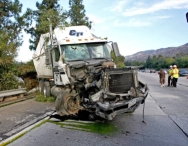The National Transportation Safety Board (NTSB) published some safety recommendations to the National Highway Traffic Safety Administration (NHTSA), on April 3, 2014. The letter, addressed to the acting administrator, David J. Friedman, calls for action in 3 areas:
- Mitigation / reduction in blind spots to protect passenger vehicles, pedestrians, bicyclists and motorcyclists from being struck by commercial motor vehicles / tractor trailers.
- Underride guards for not only the back or rear of the trailer, but also for the sides. To reduce the number of passenger vehicles that end up underneath the trailer in an accident.
- Improved data collection for trailers involved in accidents.

Blind Spot Reduction:
The NTSB is recommending that regulations require new trucks to be equipped with systems to boost blind spot awareness. The recommendations include corner mirrors and technology be used to reduce the areas where truck drivers can’t easily see, specifically on the right hand side of the vehicle. Implementing the changes that are requested will reduce the number of collisions that tractor-trailers have with pedestrians, cyclists and passenger vehicles. The death rates with each of these types of collisions would hopefully drop from: 15% of pedestrian and bicyclists collisions, 11% of motorcyclists and 10% of passenger vehicles involved in an accident result in death.
Underride Protection Systems:
Cars that end up underneath a trailer have a significantly higher amount of injuries due to the fact that in many cases the airbags of the passenger vehicle fail to deploy because the sensors fail to strike the tractor-trailer structure. In addition the passenger vehicle crumple zone designed to absorb much of the impact fails to do so as the car is underneath the trailer, and the impact misses the crumple zone.
Frequently when cars impact the trailer the damage is at the passenger level and little damage is done to the engine compartment as it slides underneath the trailer. These collisions occur both at the rear of the trailer as well as at the sides.
The NTSB recommends guards be required for trailer sides as well as trailer rears.
Data collection for trailers involved in accidents:
The NTSB recommends that trailer data collection be enhanced for trailers involved in an accident. Specifically the NTSB asks that additional data fields be required on police reports to allow more detailed analysis of the trailer characteristics which will hopefully lead to better safety information and recommendations for the manufacture of trailers. The NTSB asks that: (1) NHTSA add trailer VIN and model year to the Fatality Analysis Reporting System database, (2) add a field to include trailer license plate numbers in the next edition of the Model Minimum Uniform Crash Criteria Guideline and (3) add a field to include trailer VIN numbers in the next edition of the guideline.
According to the NTSB, these additional pieces of information would allow a more detailed study of the design of the trailers as it relates to safety. While the VIN is not located in the same place on every trailer like it is in passenger vehicles and trucks, it is not extremely difficult to locate the VIN. In addition, the license plate can help look up the VIN as generally the plate is tied to a unique VIN for the trailer. VINs can then be traced back to determine the make and year of the trailer manufacture. This information can be useful in determining trailer designs that are safer than others.

